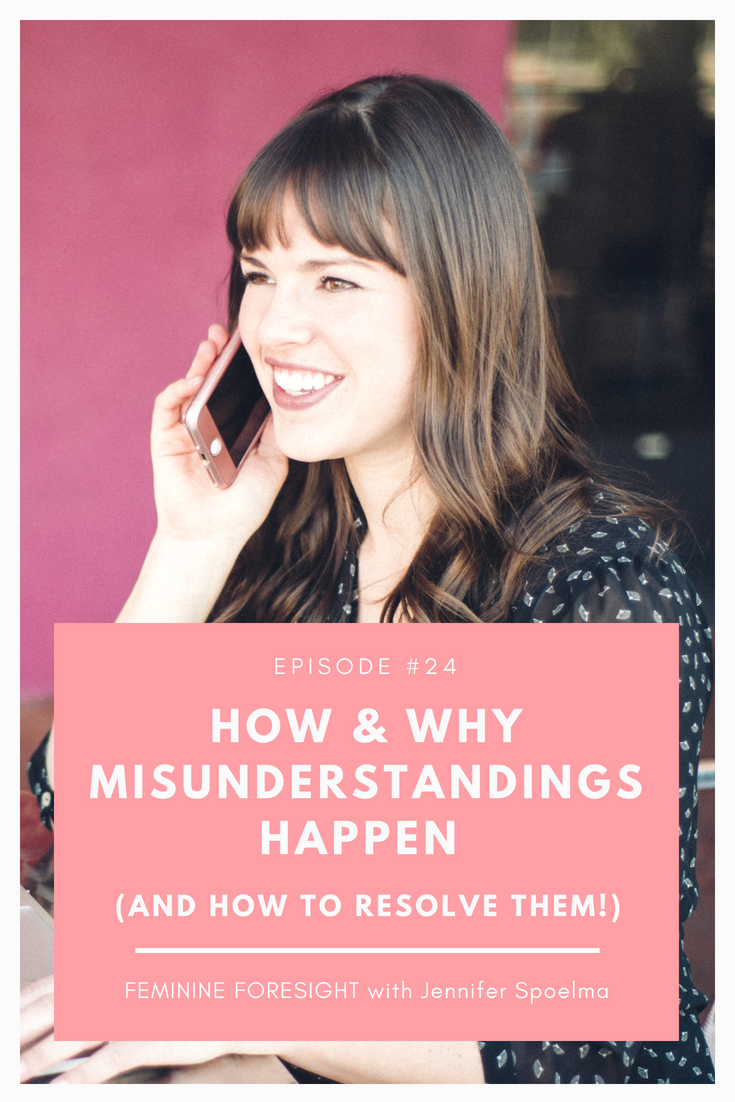Communication Breakdown: How Misunderstandings Happen and What to Do About It
Wahoo! This post marks the completion of the Feminine Foresight mini-series on misunderstanding. We’ve covered so many hefty topics over the past several weeks to understand the contributors that make us feel misunderstood. Here’s a list of the posts if you want to check any out.
And remember, there are video and podcast versions of each topic, too!
What Is the Transparency Illusion and How Does It Lead to Misunderstanding?
Why You Think People Are Paying More Attention To You Than They Really Are
How to Make a Good First Impression to Be Understood and Why It’s Worth All the Effort
Understanding Violent Agreement and How to Have Civil Conversations In Tense Times
Now that we know some of the main contributors that make US feel misunderstood, let’s take a look at what is actually occurring when a misunderstanding takes place.
Things might get a bit technical today, but stick with me through it!
Understanding the Anatomy of a Misunderstanding
Juliane House is a linguist and scholar who has significant knowledge on how and why misunderstandings happen. She has a simple definition for misunderstanding that I find helpful:
“A misunderstanding occurs when a communication attempt is unsuccessful because what the speaker intends to express differs from what the hearer believes to have been expressed.” (Misunderstanding in Social Life, 2014)
While misunderstanding might seem like one of those things that doesn’t require a definition I believe there’ benefit to it. For example, it reminds us that misunderstandings take place on a two way street. So often when we feel misunderstood it creates feelings of isolation. We tend to retreat because we feel unknown or unseen.
That may feel like the safe option, but it won’t heal the misunderstanding. To resolve a misunderstanding requires both parties to reconcile the differences between what was intended and what was perceived to have taken place.
According to House, there are two main types of misunderstandings, and three main ways in which these misunderstandings are triggered.
Let’s break these down. It may seem mechanical at first, but I believe that understanding the breakdown of misunderstanding is one of the best tools we have to remedy it.
Here we go!
The Two Main Types of Misunderstanding
The speaker is not aware that they are being misunderstood.
The listener is unaware that they are not understanding what was intended.
The road goes both ways when it comes to misunderstanding.
Have you ever heard someone say the following statements?:
“I’m sorry if you took it the wrong way”
“I’m sorry you were offended by what I said”
“I’m not responsible for how you feel about what I said or did”
It seems to be a popular trend these days, to place the burden of understanding on the listener. But is a misunderstanding something that “belongs” to the listener or audience alone? Or, are both the speaker and listener responsible?
According to the above definition, the answer is that both parties play a role!
What Are the Triggers for Misunderstanding?
Both the speaker and listener in a conversation are responsible for true understanding to occur. Below is a breakdown of how each party can contribute to a misunderstanding.
Triggers of Misunderstanding That Originate From the Speaker:
The speaker is unable to organize their intentions in their own mind. (which is the ability to cognize the information). They can’t express what isn’t yet a clear thought in their own minds. They may need time, or more information before they can make sense of the situation.
This happens a lot when someone is venting, upset or overwhelmed. Thoughts are coming out of their mouth for the first time, and often the speaker is figuring out what they mean as they speak. It’s likely that misunderstanding will result if there isn’t already a strong foundation of relationship, understanding and empathy between the speaker and listener.
I’ve run into trouble here by confiding too soon with a new coworker. I was sharing a personal story about my family and our relationship dynamics. It wasn’t that the situation was especially noteworthy, or that my colleague couldn’t be trusted with the information I shared that the misunderstanding happened.
Rather, because our relationship was so fresh, her perception of my words was very different from what I intended. Her response to my story, and how she referred to my family going forward made it clear I had not communicated what I intended to. The ripple effects of that misunderstanding lasted for months!
The speaker knows, in their mind what they want to say. But they are still unable to express their intentions effectively.
This can appear in a lot of ways. It can come across as awkwardness, bluntness, lack of emotion, conflicting body language, overuse or underuse of words, confusing arrangement of words or concepts, using words inappropriate for the audience, (obscure words, acronyms, or jargon) or leaving out important information.
A perfect example in a professional setting: Someone who is excellent at something, (like math) but a “lousy teacher.” The fault isn’t in their ability to understand a topic, they just struggle to communicate clearly with their audience.
The speaker can both organize & express their thoughts, but chooses to hold back for some reason. This can happen because the person is trying to be polite, fear of looking ignorant by “asking dumb questions,” or even due to purposely withholding information from someone who may use it against them later.
Sometimes, this is motivated by cultural norms. Other times, it can be a symptom of pride or manipulation. Think: gaslighting.
These sources of speaker-led misunderstanding are very helpful to keep in mind if you often feel your words are being misinterpreted. You can use the knowledge to help you avoid, or remedy misunderstandings.
In the example I shared about my colleague, I was able to remedy the misunderstanding in a later conversation. I said, “Remember when we had that conversation about my family? I think what I communicated was different than what I intended. It seems that the understanding you came away with was_______ But that I meant to communicate was ______.”
Next, let’s talk about what misunderstanding triggers from the listener!
Triggers of Misunderstanding That Originate From the Listener
The listener is cognitively unable to process the information conveyed by the speaker due to any number of reasons: specific learning challenges, new exposure to a topic, poor presentation, difficulty understanding a foreign accent, or even a poor connection if the conversation is happening over a phone or the internet.
For example, this is a complaint that many people have when reaching out to a company for tech support.
This can also happen in everyday conversations when the following factors are at play:
False beliefs (Having the wrong facts/information but believing them to be true)
Ignorance or gaps in objective knowledge. (Not lack of intelligence)
Bias. (For example, the connotation of a word, such as “feminist” or “immigrant”)
Lack of experience or a narrow worldview. (Inability or unwillingness to consider other perspectives)
These triggers are definitely helpful to be aware of as you listen, and as you speak.
How to be Proactive to Avoid Misunderstanding
For the speaker:
Know what your intentions are before speaking, writing, or putting your message “out there.” Are you being ambiguous in any way? Do you know your topic or your intention well enough to communicate about it, and the results you want to achieve by communicating your message?
Are you trying to teach, educate, sell a product or service, establish a relationship, help someone from your heart, or enlist help? It’s good to be clear about not just the subject matter, but your motives and intentions.
Ask questions to keep clarifying your own message. What do you need to know first, before expressing your message? Do you have enough data? Do you need to attach any sort of “disclaimer” to your message? Have you checked your motives?
For the listener:
Engage in and practice active listening. Your body language can either create an environment in which people feel safe to express themselves, or feel they need to be cautious around you. If you create a safe place, it’s more likely people will feel comfortable enough to express themselves more fully.
Clarify by asking the right questions: For example, Did I hear you say? Did you think I said/meant? Ask for more clarification and repetition if needed.
Check in with how effectively you are able to take in new information. Are you feeling tired, distracted, or overwhelmed by information or emotions?
Example: If your best friend is confiding you during a phone call, and you are exhausted and need to sleep or are distracted by the demands of work or kids, might it be better to talk when you can give your undivided attention?
Thanks for sticking with me through this more technical post. I like to think of it as a map for misunderstanding. Now that you’re familiar with the different forms it takes and when it’s likely to appear you can be prepared to remedy it quickly.

